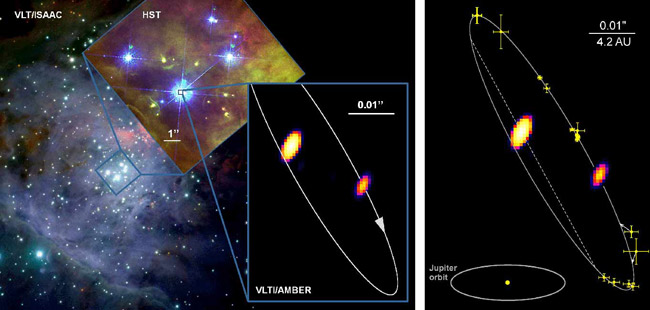New Close-up Shows Binary Stars in Orion’s Heart

This story was updated at 1:02 p.m. EDT.
Astronomershave caught their sharpest look of a double star system deep in the heart ofthe Orion nebula.
The resultis an ultra-clear glimpse of Theta 1 Orionis C, a mismatched pair of stars lockedin orbit around one another about 1,350 light-years from Earth.
Oncethought to be a single star, Theta 1 Orionis C is the brightest and mostdominant stellar system inside the dense star-forming region of Orion?s beautifulTrapezium Cluster. Infrared views of the system ultimately showed its dualnature, which shines through with renewed clarity in the new image.
Researchersused the European Southern Observatory?s Very Large Telescope Interferometer(VLTI), which combines data from multiple telescopes into one image, to makethe new observation.
TheChile-based observatory yielded a photograph with a resolution of about 2milliarcseconds. That?s about the equivalent of how a car on the moon wouldlook to a human staring at it from the surface of the Earth, or the view from ahypothetical space telescope with a 426-foot (130-meter) main mirror. Forcomparison, the main mirror of the Hubble Space Telescope isabout 7.8 feet (2.4 meters) wide.
?Ourobservations demonstrate the fascinating new imaging capabilities of the VLTI,?said study co-investigator Gerd Weigelt of the Max-Planck-Institute for RadioAstronomy. ?This infrared interferometry technique will certainly lead to manyfundamental new discoveries.?
Get the Space.com Newsletter
Breaking space news, the latest updates on rocket launches, skywatching events and more!
In additionto the new image of Theta 1 Orionis C, Weigelt and colleague Stefan Kraus foundthat the stars orbit each other once every 11 years. The smaller of the pair isabout nine times as massive as the sun, while its larger partner weighs in at whopping38 solar masses.
Solar windfrom the paired stars shapes the disks of protoplanetary dust of other nearbystars, researchers said. The new images and data will help astronomers betterunderstand howmassive stars form within the Orion nebula, they added.
Theresearch, announced today, is detailed in the journal Astronomy & Astrophysics.
- Video - Searching for Superstars
- Top 10 Star Mysteries
- Vote - The Strangest Things in Space
Join our Space Forums to keep talking space on the latest missions, night sky and more! And if you have a news tip, correction or comment, let us know at: community@space.com.

Space.com is the premier source of space exploration, innovation and astronomy news, chronicling (and celebrating) humanity's ongoing expansion across the final frontier. Originally founded in 1999, Space.com is, and always has been, the passion of writers and editors who are space fans and also trained journalists. Our current news team consists of Editor-in-Chief Tariq Malik; Editor Hanneke Weitering, Senior Space Writer Mike Wall; Senior Writer Meghan Bartels; Senior Writer Chelsea Gohd, Senior Writer Tereza Pultarova and Staff Writer Alexander Cox, focusing on e-commerce. Senior Producer Steve Spaleta oversees our space videos, with Diana Whitcroft as our Social Media Editor.









